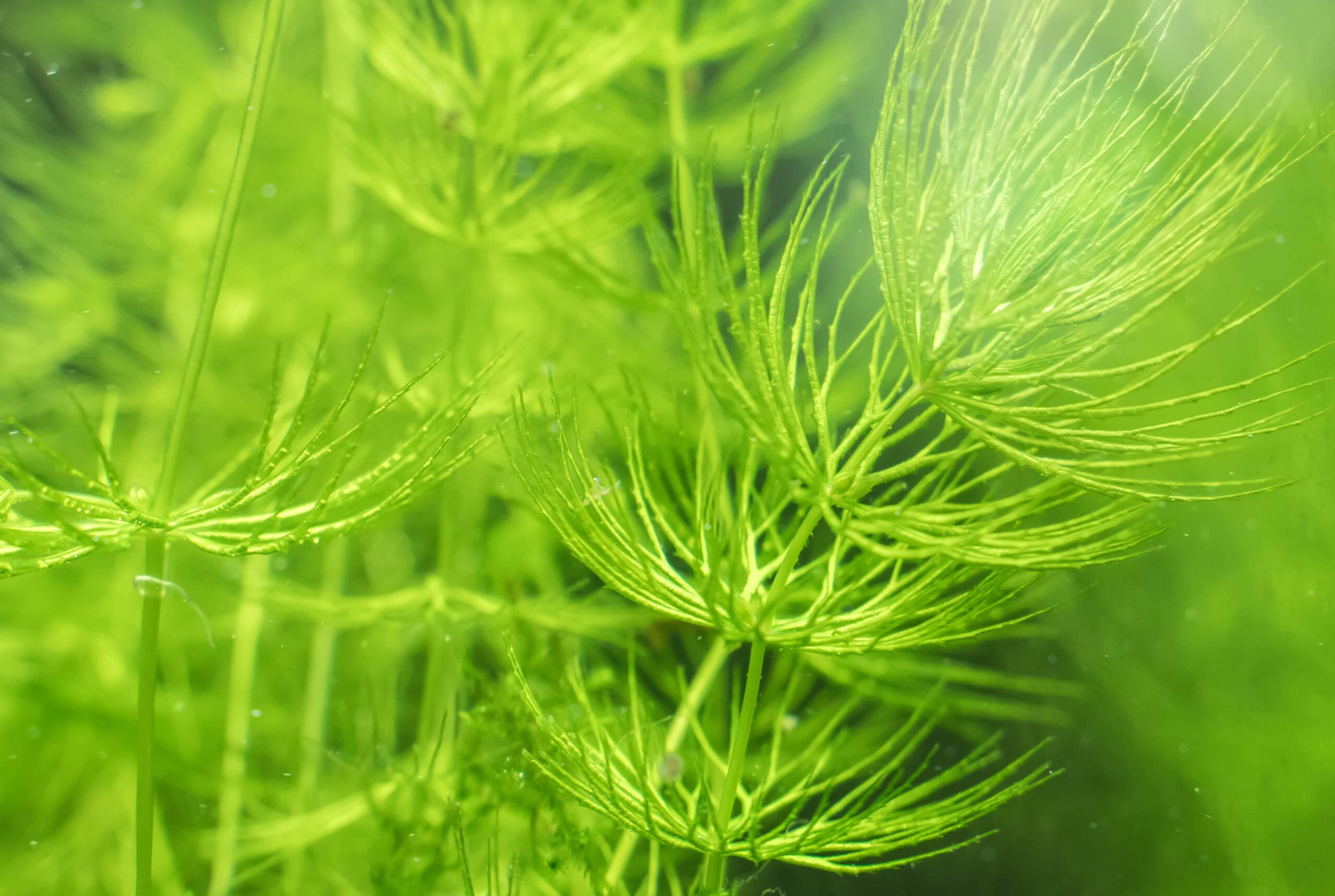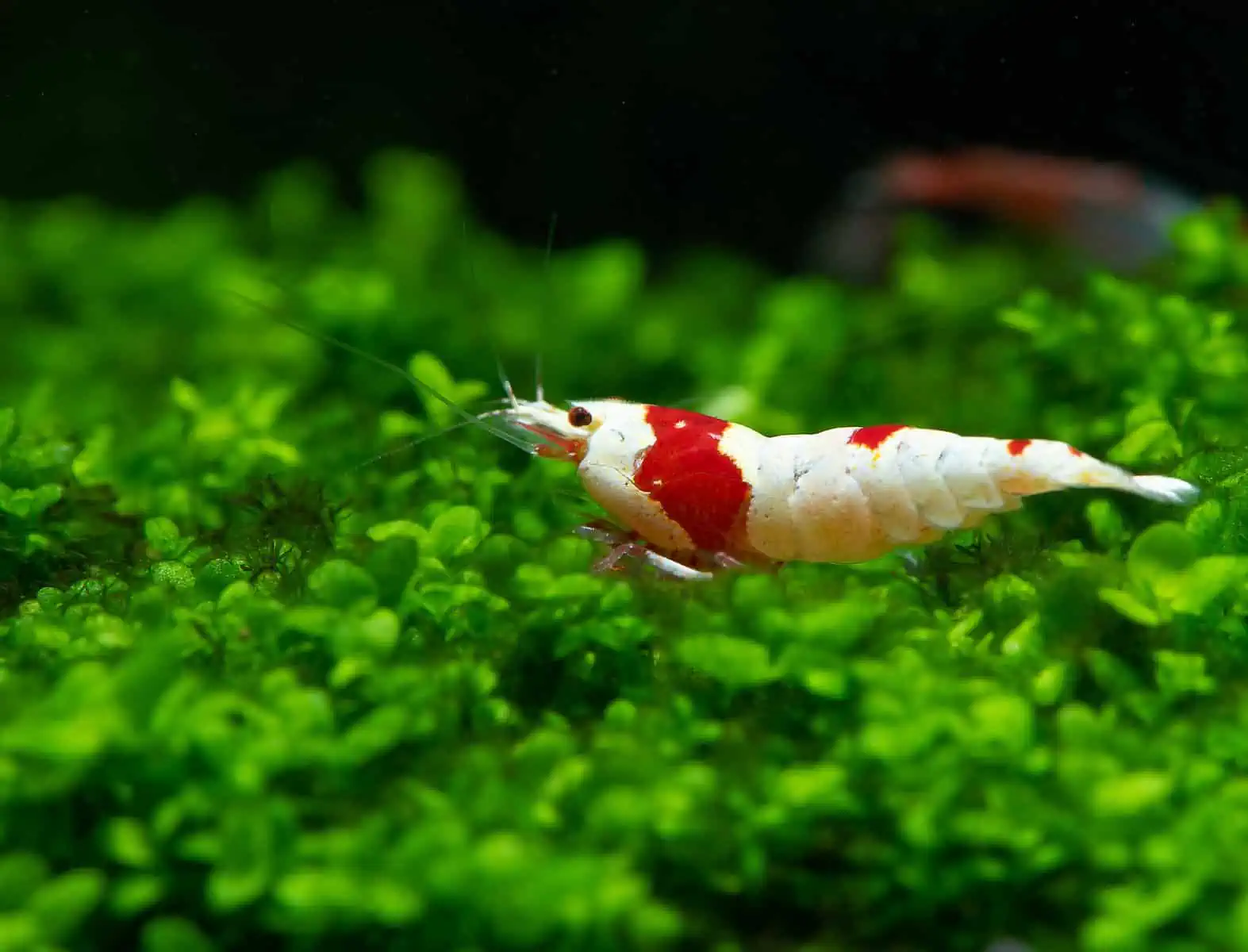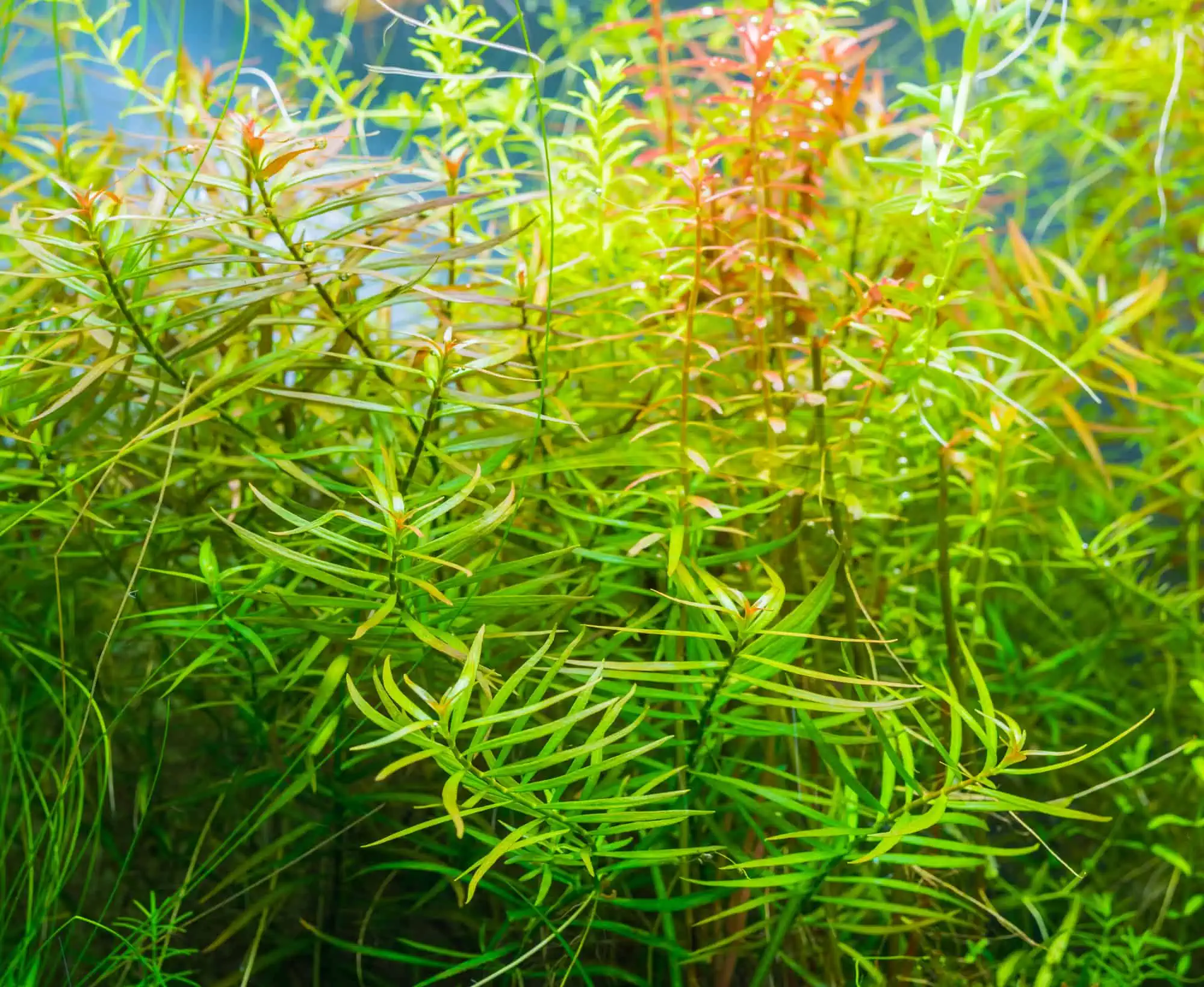Ludwigias are a popular family of aquarium plants because of their stunning red colors, but it’s important to know that some species are much easier to grow than others.
Ludwigia arcuata is a beautiful variety with slender, narrow red leaves, but it is also harder to grow than some of its relatives.
Let’s look closer at the ‘Needle leaf Ludwigia’ and find out why this colorful plant is best left to advanced aquarists and enthusiasts.
Ludwigia Arcuata Plant Profile at a Glance
| Ludwigia Arcuata Info | |
|---|---|
| Scientific Name | Ludwigia arcuata |
| Other Names | Needle Leaf Ludwigia, Narrow Leaf Ludwigia |
| Difficulty | Medium-Difficult |
| Lighting | Moderate to high |
| Optimal pH | 6-8 |
| Optimal GH | 5-30 dGH |
| Water Temperature | 68 – 82 °F (20 – 28 °C) |
| Substrate | Aquarium soil or gravel |
| Growth Rate | Slow to moderate |
| Aquascape Placement | Mid-ground and background |
| Size | Up to 20 inches high in good conditions |
| Fertilizers | Micronutrients needed |
| CO2 | Recommended |
| Propagation | Stem cuttings |
| Color | Green to red, depending on conditions |
Origins and Background
Ludwigia is a red-stemmed flowering plant that can be grown in aquariums and terrariums. Also known as ‘Needle Leaf Ludwigia, ’ it is closely related to other red aquarium plants like Ludwigia repens, Ludwigia glandulosa, and Ludwigia palustris.
Ludwigia arcuata is a freshwater plant that originates from the Southeastern USA in states like Florida and Georgia.
Size and Growth Rate
Ludwigia arcuata is a medium-tall aquarium plant growing up to 20 inches high in optimum conditions. With less fertility, however, it will reach only around 10 inches.
It prefers to take a bushy growth habit when it has adequate light and can also be pruned to keep it at the size you’re looking for.
The growth rate depends on your aquarium conditions. When the plant is given an optimum environment and sufficient light, it can put on robust growth moderately quickly, but many aquarists report it growing fairly slowly.
It’s also reported to grow faster when grown out of the water in humid conditions (emersed) than when submerged.
Tank Size
Because Ludwigia arcuata grows to a relatively large size, it’s not the best choice for tiny fish tanks, but a 10-gallon tank or larger should be ok.
In larger tanks, it can be placed in the mid-ground or background.
Water Parameters
Ludwigia arcuata seems to be tolerant of a wide range of water parameters. While many guides advise that soft, acidic water is beneficial for this plant, I’ve also read reports that it does very well in hard, alkaline water.
This makes a lot of sense since its natural habitat in states like Florida often has hard water. Because of this, I’d suggest that a good pH for these plants would be anywhere between pH 6-8, with water hardness between 5-30 dGH.
Substrate
For Ludwigia arcuata to be at its best, it needs adequate nutrition. A good aquarium soil will be the best choice to provide the plant with a steady supply of abundant nutrients in the long run.
Another option would be to plant Needle Leaf Ludwigia in gravel with root tabs to feed it.
While this plant would probably also succeed in aquarium sand, this would be my last choice of aquarium substrate. Sand can get compacted, lack oxygen, and make rooting more difficult for aquatic plants.
Lighting
Now, for the most important aspect of growing Ludwigia arcuata – you absolutely must have good lighting! Strong lighting is especially important if you boost the tank with extra CO2.
Because of its red pigment, Needle Leaf Ludwigia needs extra strong light to photosynthesize effectively. For this reason, the plant is not the best choice for beginner, low-tech tank setups.
To avoid disappointment, choose LED or fluorescent bulbs with higher PAR values. It will help the plant grow vigorously, display its more intense colors, and form an attractive bushy shape rather than long, thin stems.
We recommend keeping the lights on a timer switch for 10-14 hours a day.
Does Ludwigia Arcuata Need Fertilizer?
Ludwigia arcuata requires reasonably good nutrient sources to grow vigorously, so some sort of plant fertilizer is recommended.
If it’s growing in good aquarium soil, there may be adequate nutrient levels for the plant to grow for several years without supplements. Otherwise, root tabs or liquid-based aquarium plant feeds will be necessary to deliver the plant with sufficient minerals and micronutrients.
Just be careful not to use a fertilizer that contains nitrates since too much nitrates can cause this plant to lose its attractive red color. The maximum nitrate level for Ludwigia arcuata is 20 ppm, which is the same concentration recommended for aquarium fish.
A note of caution about plant foods that contain copper! Even small amounts of copper are highly toxic to invertebrates like shrimp and snails. If you have invertebrates in your tank, you must choose a fertilizer without added copper compounds!
CO2 Injection
Although it’s not a strict necessity, Ludwigia arcuata will grow much better with a CO2 injection system. Without CO2, plants may grow more slowly and weakly.
If you don’t have a CO2 injection system, don’t worry, there are plenty of other aquarium plants you can grow without one, including red plants like Ludwigia repens.
You can learn more about CO2 injection systems and regulators in our dedicated guide here.
Pruning
If you give Ludwigia arcuata the ideal conditions, it will grow fairly large, reasonably quickly. If it begins to crowd out other plants or look scruffy, you’ll need to give it a prune.
Pruning typically consists of simply cutting the top few inches from the tops of the stems. Not only does this control the plant’s size, but it also encourages attractive, compact, bushy growth.
When pruned back hard, it can also be utilized as a shorter midground plant rather than a taller background plant.
Ludwigia Arcuata Propagation
Propagating aquatic stem plants goes hand in hand with pruning. Simply snip off 5-8 inch long stems and place the bottom of the stem in the substrate, at least 2 inches deep.
Stems should soon grow roots and start ascending.
For faster growth, you could use a specially dedicated tank to give cuttings optimal levels of light and nutrients. You could also do this in pots in a mist unit.
Companion Plants and Aquascaping

The deep red leaves of Ludwigia arcuata look stunning in combination with plants with green leaves.
It can be planted in the background of an aquascaped aquarium alongside tall green plants like Amazon sword, Limnophila Sessiliflora, Blue Water Hyssop, Hornwort (Ceratophyllum demersum), Brazilian Pennywort (Hydrocotyle leucocephala).

In the mid-ground, you could go for medium-sized plants like Corkscrew Vallisneria (Vallisneria torta) and Java Fern (Leptochilus pteropus).
In the foreground, the smallest aquarium plants like Dwarf hair grass (Eleocharis parvula), Anubias nana, and Java moss will be the most suitable.
Compatible Fish and Invertebrates

Ludwigia arcuata will grow fine alongside any tropical aquarium fish, shrimp, and snails that don’t love to eat aquarium plants!
This means that most species will be fine, but not notorious plant eaters like Silver Dollars, Oscars, and Colombian Ramshorn Snails.
Ludwigia Arcuata Selected Cultivars

As with other Ludwigia species, plant breeders have been selecting plants with the brightest red pigments to breed from. One popular variety with a particularly strong color has been branded ‘Deep Red.’
It’s important to note that vivid red colors will only reach their full potential when given strong lighting.
Ludwigia Arcuata Buyer’s Guide
Because it isn’t the ideal beginner’s plant species, Ludwigia arcuata isn’t as readily available in pet stores as some other live plants. Nevertheless, you’ll occasionally see it for sale in larger pet stores and online outlets.
You can expect to pay upwards of $5 for a well-formed plant. Selected cultivars may be more expensive.
Can You Grow Ludwigia Arcuata Out of Water?
Not only is it possible to grow Ludwigia arcuata on land (emersed) in humid conditions, it will actually grow more vigorously out of water!
The extra light and CO2 available will help emersed plants grow more robustly, but it will also cause the leaves to grow green!
Because it’s possible to grow Ludwigia arcuata out of the water, it also does well growing in suitable terrariums, paludariums, and vivariums.
Can You Grow Ludwigia Arcuata in a Cold Water Aquarium?
Although it will tolerate temperatures down to 68°F, my research suggests it grows better at warmer temperatures.
Because cool temperatures can cause the leaves to disintegrate and ‘melt’, it’s recommended to only grow this plant in a heated aquarium unless you have a very warm room that’s permanently warmer than 72°F or so!
Conclusion
Ludwigia arcuata is a beautiful, slender-leaved aquarium plant but is rather more demanding than many other red-stemmed species.
Because it needs strong lighting, fertilizers, and CO2 injection to grow well, I’d recommend it only for advanced aquarists with plenty of experience growing live plants.
For a much easier-to-grow red-leaved aquatic plant, I’d recommend Ludwigia repens, aka. Creeping Primrose Willow. It has broader leaves and can be grown without CO2 injection or much additional fuss or fertilizers.



